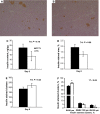Effects of heat stress on carbohydrate and lipid metabolism in growing pigs
- PMID: 25716927
- PMCID: PMC4393217
- DOI: 10.14814/phy2.12315
Effects of heat stress on carbohydrate and lipid metabolism in growing pigs
Abstract
Heat stress (HS) jeopardizes human and animal health and reduces animal agriculture productivity; however, its pathophysiology is not well understood. Study objectives were to evaluate the direct effects of HS on carbohydrate and lipid metabolism. Female pigs (57 ± 5 kg body weight) were subjected to two experimental periods. During period 1, all pigs remained in thermoneutral conditions (TN; 20°C) and were ad libitum fed. During period 2, pigs were exposed to: (1) constant HS conditions (32°C) and fed ad libitum (n = 7), or (2) TN conditions and pair-fed (PFTN; n = 10) to minimize the confounding effects of dissimilar feed intake. All pigs received an intravenous glucose tolerance test (GTT) and an epinephrine challenge (EC) in period 1, and during the early and late phases of period 2. After 8 days of environmental exposure, all pigs were killed and tissue samples were collected. Despite a similar reduction in feed intake (39%), HS pigs tended to have decreased circulating nonesterified fatty acids (NEFA; 20%) and a blunted NEFA response (71%) to the EC compared to PFTN pigs. During early exposure, HS increased basal circulating C-peptide (55%) and decreased the insulinogenic index (45%) in response to the GTT. Heat-stressed pigs had a reduced T3 to T4 ratio (56%) and hepatic 5'-deiodinase activity (58%). After 8 days, HS decreased or tended to decrease the expression of genes involved in oxidative phosphorylation in liver and skeletal muscle, and ATGL in adipose tissue. In summary, HS markedly alters both lipid and carbohydrate metabolism independently of nutrient intake.
Keywords: Epinephrine challenge; glucose tolerance test; heat stress; metabolism; thyroid hormones.
© 2015 The Authors. Physiological Reports published by Wiley Periodicals, Inc. on behalf of the American Physiological Society and The Physiological Society.
Figures



References
-
- Alamer M. The role of prolactin in thermoregulation and water balance during heat stress in domestic ruminants. Asian J. Anim. Vet. Adv. 2011;6:1153–1169.
-
- Baumgard LH. Rhoads RP. Effects of heat stress on postabsorptive metabolism and energetics. Annu. Rev. Anim. Biosci. 2013;1:311–337. - PubMed
-
- Baumgard LH, Wheelock JB, Sanders SR, Moore CE, Green HB, Waldron MR, et al. Postabsorptive carbohydrate adaptations to heat stress and monensin supplementation in lactating Holstein cows. J. Dairy Sci. 2011;94:5620–5633. - PubMed
-
- Bouchama A. Knochel JP. Heat stroke. N. Engl. J. Med. 2002;346:1978–1988. - PubMed
-
- Brelje TC. Sorenson RL. Role of prolactin versus growth hormone on islet B-cell proliferation in vitro: implications for pregnancy. Endocrinology. 1991;128:45–57. - PubMed
LinkOut - more resources
Full Text Sources
Other Literature Sources

